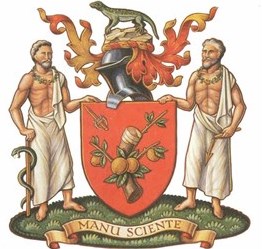The Salamander Logo
Why a Salmander?
Prominently depicted on all BAPRAS-related documentation and websites is a small creature sprawling in a tiny purple pool. Often mistaken as a “lizard”, it is in fact, a Salamander. There are many species “Salamandridae”, the family which includes newts. Similar in appearance to a lizard, they are amphibians, not reptilian, native to freshwater and belly-crawling through the shaded damp of Northern hemisphere woodland. Absorbing water through moist skin, and sometimes exuding toxins from it, they have four limbs, a short body and long tail. Most are 10-20cm in length, but some giant Japanese and Chinese salamander can reach 1.8-2 metres.
So why does BAPRAS associate the Salamander with its identity and logo? A Salamander’s distinguishing feature, and relevance to plastic surgeons is its ability to regenerate lost body parts. In response to injury or predator attack, they can re-grow, or regenerate, whole limbs, their tails and even, including the lens and retina of their eyes. How they do this, rather than just healing by scar formation, as humans do, is the subject of much research.
Mythology
Salamanders are mythological creatures. They were long thought capable of resisting fire and flame. Leonardo Da Vinci believed they derived energy from fire, whilst both Aristotle and Pliny reported their cool skin’s ability to extinguish flame. It was even believed that they could transfer fire retardant properties to man if their skin (described by William Caxton in 1481 as “wool”) were used to weave garments.
BAPS becomes BAPRAS

In July 2006 the British Association of Plastic Surgeons (BAPS) changed its name to the British Association of Plastic Reconstructive and Aesthetic Surgeons (BAPRAS). This not only involved a change of name, but a change of image and identity too.
A new logo was sought to supersede the long used and very familiar BAPS coat of arms, granted by the College of Arms in 1955. It had been noticed that a “lizard” apparently sat on a rock at the top of the original arms. BAPS founding Archivist, Mr Antony Wallace suggested that the “lizard” had been chosen for its remarkable ability to regenerate body parts. An ability to perfectly replace function and form following major tissue loss represented an ideal in reconstruction for which plastic surgery strives.
A New Identity
With the salamander’s real and imagined abilities, together with its presence on the old coat of arms, BAPRAS decided to adopt it as their new logo. There remained however considerable debate in Council about the number of digits to be depicted and whether or not they should be webbed. Salamanders don’t possess webbed digits. The number of such digits also varies between their fore and hind limbs, and the sub-species. Our Salamander has four digits on the fore limb and five on the hind. The purple colour, (officially Pantone 221) was chosen to reflect a sense of authority and a link with royalty given our patron at the time, HRH Prince Phillip, Duke of Edinburgh.
The new logo was adopted in 2006 at the time of the Association name change. In recognition of the previous 50-year history of the Association and its significance to the senior members, it was decided to retain the old crest in some form. Thus, where it appears now, the old coat of arms is depicted in warm grey tones, rather than its original colours, seen above.